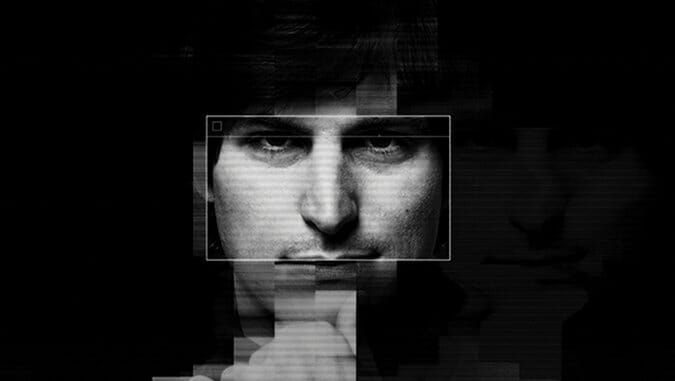
Who better than Alex Gibney to profile Steve Jobs? Well, probably plenty of directors, but still: Gibney has a reputation as an incisive, no-nonsense documentarian with a keen mind for layered investigation and an impressive bullshit detector. He’s also old hat at dissolving the facade of celebrity—as in his 2013 picture, The Armstrong Lie—and at yanking corruption and wrongdoing into the daylight, as in the Emmy nominated Going Clear: Scientology and the Prison of Belief, which arrived earlier this year. In both films, Gibney’s mission is laid out in the first few minutes: Expose the truth, disperse the lie and gently proceed without mercy.
So if anyone can parse the many faces of Jobs, late Allfather of modern technology and veteran scoundrel, Gibney’s near the top of the list. Steve Jobs: The Man in the Machine might be as close to a sure thing on paper as any documentary can be, but there’s a problem: Jobs, it turns out, is too much of a challenge even for Gibney to tackle. That’s a shock, but then, Jobs is basically an endless Russian nesting doll of ambition, fear, anxiety, malice, creativity, deceit, passion and, at the center of all that, heart. Based on the film’s lengthy running time, Gibney is aware that the task of turning a god mortal is not to be taken lightly, but Jobs meant so many different things to so many different people—plus an entire industry—that two hours feels inadequate.
Steve Jobs: The Man in the Machine opens with footage of consumers laying wreaths at Apple stores and sharing their video testimonials/eulogies on the web. The images, taken at once, are staggering: How could so many people experience such real grief at the death of a man they never met? Incredibly, though, Gibney’s starting point is also his first stumbling block. Is it worth mulling over the fanatical devotion Apple loyalists feel toward their iStuff? Absolutely, particularly as Gibney takes us down the corporate rabbit hole and reveals that Apple isn’t the company we all think it is, or want it to be. There’s a seductive quality to the idea that among tech giants, Apple is fighting the good fight by making gadgets that enhance us, let us express ourselves, let us connect with one another and make the world a smaller, better place.
It’s a lie, of course, but you’d have to crawl stroke through Kool-Aid daily not to realize it. After presenting his thesis, Gibney wanders all the way back to the 1970s, when Jobs and Steve Wozniak were cooking up blue boxes—nifty gizmos that let people make free long distance phone calls—and birthing the first Apple computer. We know where the movie is going to take us from here: All the way up to where we began. This makes sense inasmuch that if you want to understand Jobs’ cult of personality, you need to understand Jobs himself, but as Steve Jobs: The Man in the Machine pores over history, it becomes an entirely different film than the one with which Gibney commences. He buries the lede.
The effect is deeply muddling. It’s no small thing that Jobs treated his colleagues poorly, his employees worse, and journalists even worse than that. He broke laws, gamed the system, and smushed anybody in his way beneath the bootheel of his net worth. But nobody needs Gibney to commit Jobs’ transgressions to film. The Internet has captured them all in HTML-coded amber—you can save yourself the trouble of watching Steve Jobs: The Man in the Machine with Google searches: “apple tax haven ireland,” “apple wage collusion,” “steve jobs chrisann brennan.” Early on, Wozniak recalls the time Jobs lied to him about the paycheck they earned together making a version of Pong for Atari. You can find that tidbit online, too, with only a few keystrokes of effort.
Gibney doesn’t tell us anything we don’t already know or can’t figure out for ourselves. His interviews with Jobs’ friends, family and peers—Nolan Bushnell, Michael Moritz, Sherry Turkle, Daniel Kottke—lend the most insight, both into whom Jobs was and why we all go gaga over Apple devices. In one moment, Bob Belleville, the head of engineering on the original Macintosh, brings out that dusty beige box and gazes at it with the sort of loving adoration usually reserved for children. There is something special, something intangibly unique, about these machines, and, yes, even about Jobs. He died four years ago, but his influence persists to this day in subtle and overt ways. (You might, for example, be reading this review on your subway ride home as you listen to The Weeknd’s latest album and zone out the world. Behold: Jobs at work.)
But Steve Jobs: The Man in the Machine really isn’t about all that—its scope is too wide. And when Gibney narrows it, the film threatens to find a groove and become engaging. One segment allows Lisa, his eldest daughter, to describe her father in her own words through prandial bonding. Salads and sushi: That’s Jobs in an emotional nutshell. He’s a mass of contradictions and idiosyncrasies, a guy who’s more comfortable connecting with PCs than with people.
Maybe we can’t ever really understand people like Jobs, and maybe that’s why Gibney’s film feels so insubstantial, so lacking, so plodding and so obvious. Maybe that’s also why we need two movies about Jobs in one year. (Danny Boyle’s Steve Jobs premieres this October.) Let’s see if Hollywood can beat Gibney at his own game.
Director: Alex Gibney
Release Date: September 4, 2015
Boston-based critic Andy Crump has been writing online about film since 2009, and has been scribbling for Paste Magazine since 2013. He also contributes to Screen Rant, Movie Mezzanine and Badass Digest. You can follow him on Twitter. He is composed of roughly 65% Vermont craft brews.